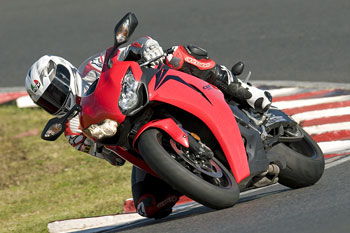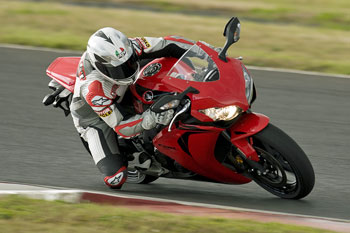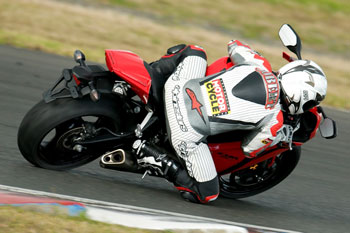MotoOnline.com.au puts Honda’s hugely successful Fireblade through its paces on the road and track in New South Wales.

2009 HONDA CBR1000RR SPECIFICATIONS
ENGINE
Engine type: Liquid-cooled 4-stroke 16-valve DOHC inline-4
Bore x stroke: 76 x 55.1mm
Displacement: 999cc
Compression ratio: 12.3:1
Transmission: Six speed
Power: 172 hp
Torque: 71ft-lbs
CHASSIS
Frame type: Die-cast aluminium twin-spar
Front suspension: 43mm fully adjustable inverted HMAS cartridge-type telescopic fork
Rear suspension: Unit Pro-Link with gas charged remote reservoir damper, adjustable spring preload, compression and rebound damping
Wheels (front/rear): 17 x 3.5 / 17 x 6.0
Tyres (front/rear): 120/70-17 / 190/50-17
Brakes (front/rear): 2 x 310mm hydraulic disc with radial mount 4-piston callipers, floating rotors and sintered metal pads / 1 x 220mm hydraulic disc with single-piston calliper and sintered metal pads (e-CABS optional)
DIMENSIONS
Weight (claimed): 199kg (210kg with e-CABS)
Seat height: 820mm
Wheelbase: 1410mm
Fuel capacity: 18L
PURCHASE DETAILS
Price: Standard $19,490; Repsol colour standard $19,990; e-CABS $20,490 (plus orc and dealer pre-delivery charges)
Colour options: Red; Black; White; Repsol (standard version only)
Warranty: 24 Months
Test bike: Honda Australia
www.hondamotorcycles.com.au
It’s hard to believe that it’s taken us until December 2009 before uploading a test of Honda’s CBR1000RR Fireblade, winner of so many media accolades since the current model’s release last year.
The Blade has claimed Australian Motorcycle News magazine’s AUStest (Australia’s Ultimate Sportsbike) trophy on the track for the last two years in succession, also coming out on top in the road segment of the test in its inaugural running in 2008.
Its results all-round are exceptional, with riders throughout the world hailing the step forward that Honda has achieved with the latest incarnation of the big-bore CBR to make it handle delightfully well in the twisties while feeding it plenty of mumbo in the a straight line.
Ergonomically speaking, nothing out of the ordinary is felt when you’re in the seating position and the handlebars are set high to add to the comfort level when riding on the roads of the real world.
The foot rests are in a comfy position that seems to suit almost any size rider, while the wind resistance behind the windscreen and fairing is actually surprisingly good thanks to the flat shape of the front-end.
You can also be assured that the mirrors equipped on the Blade are some of the best in the superbike category, quite large with a lot of adjustability to create a decent rear view while also being foldable if it’s a tight squeeze in your garage.
Honda’s superbike doesn’t scream out luxury like some of the mre pricey European brands available on the market, but it does feature high quality components from every angle, getting the job done in a simple, yet effective manner that makes it a cinch to ride – and fast.
You either tend to love or hate the look of the Blade, but if one thing’s for certain it’s that the bike has grown on a lot of people over the last two years. It’s flat-nosed at the front, while scaling down into a very minute rear-end.
Its stubby exhaust that peaks out from beneath the lower section of the right-hand side of the bike adds to the sleek look, proving much more effective than the underseat exhaust that was utilised on the previous model.
The twisties and tighter roads are delightful on the Honda as it makes the most of a die-cast aluminium frame equipped with Showa suspension and Tokico (front) and Nissin (rear) brake systems.
Honda shocked the industry when it released the most precise handling 1000cc superbike ever last year, taking litre bike handling to the next level – a level which isn’t too far off of the dream response of supersport riding.
Handling-wise the Blade is a very difficult bike to surpass, with a light feel that allows riders to feel in control at all times, really enabling you to grab it by the scruff of the neck and push to reach your limits.
The standard Dunlop Qualifiers (different to the Australian aftermarket version) make the CBR1000RR turn slower than it otherwise would and a bit spongier in the handling department on track, but take it on the street and the grip is quite good while also remaining ideal for rain riding.
The Showa suspension is soft in its stroke without bottoming, and it remains in control when rebounding over bumps on even the bumpiest of roads if you take a wrong turn onto the rough stuff.
Turning into each and every corner is predictable in the way that it steers whether you’re tackling a high- or low-speed section of road, and it manages to hold its line greatly as you accelerate through and out of the turn.
Any sign of headshake is eliminated by the HESD Steering Damper that comes standard on the bike, developed in MotoGP and Superbike racing, leaving it up to you to get your lines right and then twist the throttle as hard as you dare.
Overall the suspension is a good compromise for road and track, because while it works well on the street, you can push quite hard on the circuit with only minimal suspension revisions if you feel the need – just make sure you mount some stickier tyres for circuit use.
The reason the CBR is so good and so competitive when it comes to AUStest, where you get minimal laps on each bike, is because it is just so easy to climb aboard and ride with utter ease whether you’re experienced on superbikes or not.
Adding to the safety concept of the Fireblade, this year sees Honda introduce the bike in a separate model to the standard version, featuring the revolutionary e-CABS (electronically-controlled Anti-lock Braking System), which Honda has designed to increase safety on the public roads.
The e-CABS brakes aren’t intended for circuit use as a performance product, although the simple fact of having ABS brakes available as an option on sportsbikes (the CBR600RR is also available with e-CABS) is yet another massive development in this currently mind-blowing era.
I’ve ridden both the e-CABS and standard versions of the Blade, with the ABS model having a much more ‘wooden’ feel to the lever, although working exceptionally well when you slam on the brakes for an emergency stop.
Meanwhile, the standard version has a much more traditional braking feel that offers more of a spongy feel when you squeeze the lever, with this version much more suited to track riding.
Personally, if I was buying a bike for track use in racing or for ride days I’d buy the standard version, while if I was predominately a road user I’d spend the extra cash and take advantage of the ABS – especially in the rain.
The Fireblade’s inline four-cylinder engine is an absolute powerhouse on the dyno with 172 horsepower at 12,210rpm, while also standing tall with a torque measurement of 81ft-lbs at 10,180rpm.
Despite its high output of power, smooth is the key word when it explaining it because it rolls on without a hitch, accelerates hard, and has plenty of overrev has you search to extract all you can from the top-end.
With an engine that is crisp and responsive, strong throughout the rev range and easy to use no matter what your skill level, the Fireblade provides the ultimate package of performance and usability.
The muffler note could have a little more bark to it, but that’s nothing that an aftermarket exhaust won’t solve, and you’ll be delighted with the precise shifting manner of the gearbox as you work through the six speeds.
Adding to its plusses, fuel consumption is a very strong factor of the engine when riding on the street, getting 6.4L/100km in a dose of riding at speed on some of the country roads of NSW.
Its dash is very simple to use with two buttons mounted next to the analogue tacho, while a digital display reads the speedo, odometer, duel trip metres, fuel measurements, clock, engine temperature, and the usual array of warning and indicator lights.
In summary, there’s no doubt that Honda’s onto a winner with its latest in the epic Fireblade family, doing many things very well but still a little less exciting than some of the other newer models now available.
The most difficult thing for Honda to do from this point is coming up with a replacement, because we’re now heading into the third year of production for this variant of the Fireblade and it’s still easily ranked up there with the best.










Newsletter